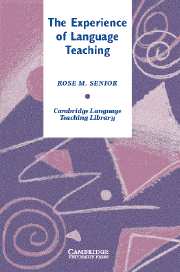Book contents
- Frontmatter
- Contents
- List of figures
- Acknowledgements
- Preface
- Introduction
- 1 Establishing a framework for the book
- 2 Training to be a language teacher
- 3 Becoming a committed language teacher
- 4 Establishing the learning environment
- 5 The diversity of the language classroom
- 6 Managing individuals
- 7 Teaching flexibly
- 8 Vitalising the language class
- 9 Maintaining the classroom community
- 10 Frustrations and rewards
- 11 What drives language teachers
- 12 Towards a teacher-generated theory of classroom practice
- References
- Index
9 - Maintaining the classroom community
Published online by Cambridge University Press: 05 November 2012
- Frontmatter
- Contents
- List of figures
- Acknowledgements
- Preface
- Introduction
- 1 Establishing a framework for the book
- 2 Training to be a language teacher
- 3 Becoming a committed language teacher
- 4 Establishing the learning environment
- 5 The diversity of the language classroom
- 6 Managing individuals
- 7 Teaching flexibly
- 8 Vitalising the language class
- 9 Maintaining the classroom community
- 10 Frustrations and rewards
- 11 What drives language teachers
- 12 Towards a teacher-generated theory of classroom practice
- References
- Index
Summary
The previous chapter focused on the different ways in which language teachers vitalise the classroom environment. It drew particular attention to the key role that laughter plays in enabling teachers to judge the overall level of responsiveness of their classes. It also demonstrated how humorous initiatives and responses inject a feeling of vitality into language classes. The central part of the chapter highlighted the danger of confusing enjoyment with language learning, while the final part showed how the atmospheres of language classes are vitalised when students are engaged in learning tasks in ways that are personally meaningful and satisfying. The chapter concluded by highlighting the reciprocal nature of the vitalisation process.
This chapter focuses on how language classes function as communities of learners, with language teachers and their students interacting with one another in dynamic ways to develop the unique cultural environment of each language class. It is divided into three sections. Section 9.1 describes the kinds of shared understandings that routinely develop over time as the individual culture of each language class evolves and becomes readily identifiable. Section 9.2 focuses on group dynamics in the language classroom, showing how the ways in which language classes function as communities of learners can be understood in terms of the construct of cohesiveness. It also draws attention to potential problems associated with perceiving classes of language learners as cohesive. The third section of this chapter, Section 9.3, focuses on the techniques that language teachers commonly use to maintain a sense of community in their classes.
- Type
- Chapter
- Information
- The Experience of Language Teaching , pp. 199 - 227Publisher: Cambridge University PressPrint publication year: 2006
- 1
- Cited by



